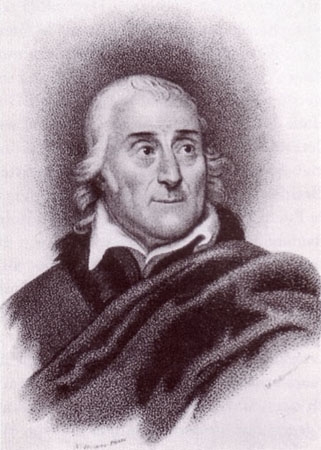<Back to Index>
- Botanist and Zoologist Georg Wilhelm Steller, 1709
- Librettist Lorenzo Da Ponte, 1749
- Emperor and Autocrat of All the Russias Alexander III Alexandrovich, 1845
PAGE SPONSOR

Lorenzo Da Ponte (10 March 1749 - 17 August 1838) was a Venetian opera librettist and poet. He wrote the librettos for 28 operas by 11 composers, including Mozart.
Lorenzo Da Ponte was born Emanuele Conegliano in Ceneda, in the Republic of Venice (now Vittorio Veneto, Italy). He was Jewish by birth. His parents were Geremia Conegliano and Rachele Pincherle. He had two brothers; Baruch (born in 1752) and Anania (born in 1754). Rachele died giving birth to Anania in 1754. Geremia Conegliano, the widowed father, converted himself and his three sons to Roman Catholicism in order to marry eighteen year old Orsola Pasqua Paietta. She was only four years older than Emanuele, then 14 years old. Emanuele took the name of Lorenzo da Ponte from the Bishop of Ceneda who baptised him. He studied to be a teacher and was ordained a Catholic priest. While priest of the church of San Luca in Venice, he took a mistress, Anzoletta Bellaudi, who was married. Da Ponte delivered their first child, an event which he commented on as "the kind of incident that happens every day." Reprimanded by the vicar-general, Da Ponte and Anzoletta opened a brothel. Charged with "public concubinage and rapito di donna onesta" (abduction of a respectable woman), Da Ponte was banished from Venice for fifteen years.
Da Ponte travelled to Austria, and applied for the post of Poet to the Theatres. Emperor Joseph II asked how many plays he had written. Da Ponte replied "None, Sire," to which the Emperor replied "Good, good! Then we shall have a virgin muse." As court librettist, he wrote texts in French, German, Spanish, and Italian, and collaborated with Wolfgang Amadeus Mozart, Antonio Salieri, and Vicente Martín y Soler.
Sometime
around 1792, da Ponte was introduced to Ann Celestine Grahl (known more
commonly as Nancy), a woman twenty years younger than him, who became
his wife for the latter part of his life and was mother to da Ponte's
four children: Louisa (1794), Fanny (1799), Joseph (1800), and Lorenzo
(1804). With the death of Joseph II, da Ponte lost his patron, and he received little interest from the new Emperor. He moved to Prague briefly, and then to London.
He started a new career there as an opera producer. But he had little
head for business, and eventually found himself in bankruptcy. To
escape his creditors, he fled to the United States. In the United States, da Ponte settled in New York first, then Sunbury, Pennsylvania,
where he briefly ran a grocery store and gave private Italian lessons.
He returned to New York to open a bookstore. He became friends with Clement Clarke Moore, and, through him, gained an appointment as the first professor of Italian literature at Columbia College.
He was the first Roman Catholic priest to be appointed to the faculty,
and he was also the first to have been born a Jew. In New York he
introduced opera and produced a performance of Don Giovanni. He also introduced Gioachino Rossini's music in the U.S., through a concert tour with his niece Giulia da Ponte. In 1828, at the age of 79, Da Ponte became a naturalized U.S. citizen. He died in 1838 in New York; an enormous funeral ceremony was held in New York's old St. Patrick's Cathedral on Mulberry Street. Da Ponte is buried in Calvary Cemetery in Queens. All
of Da Ponte's works were adaptations of pre-existing plots, as was
common among librettists of the time, with the exceptions of L'arbore di Diana with Vicente Martín y Soler, and Così fan tutte,
which he began with Salieri, but completed with Mozart. However the
quality of his elaboration gave them new life, in particular the Don
Giovanni character, often seen in contrast with Giacomo Casanova as the archetypical libertine character.